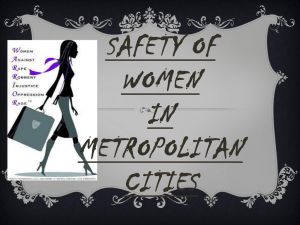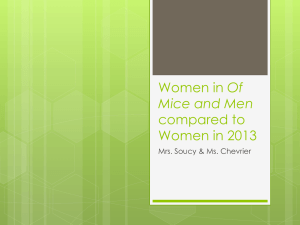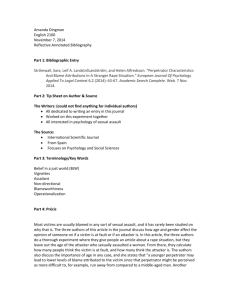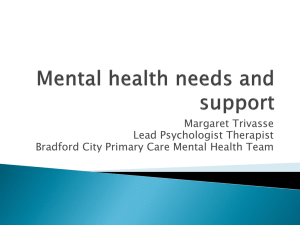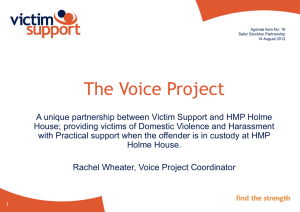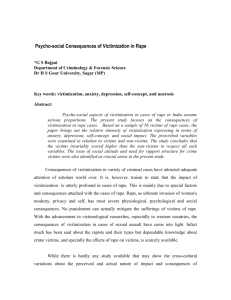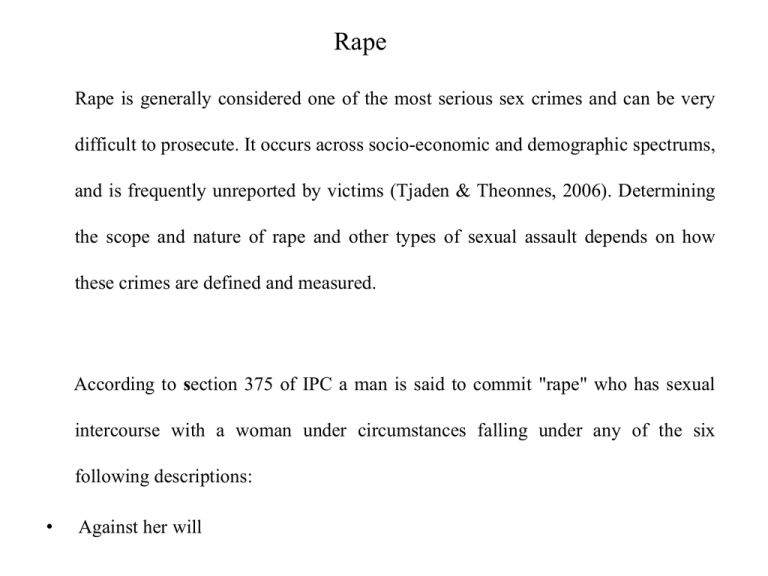
Rape
Rape is generally considered one of the most serious sex crimes and can be very
difficult to prosecute. It occurs across socio-economic and demographic spectrums,
and is frequently unreported by victims (Tjaden & Theonnes, 2006). Determining
the scope and nature of rape and other types of sexual assault depends on how
these crimes are defined and measured.
According to section 375 of IPC a man is said to commit "rape" who has sexual
intercourse with a woman under circumstances falling under any of the six
following descriptions:
•
Against her will
•
Without her consent.
•
With her consent, when her consent has been obtained by putting her or any person
in whom she is interested in fear of death or of hurt.
•
With her consent, when the man knows that he is not her husband, and that her
consent is given because she believes that he is another man to whom she is or
believes herself to be lawfully married.
•
With her consent, when, at the time of giving such consent, by reason of
unsoundness of mind or intoxication or the administration by him personally or
through another of any stupid flying or unwholesome substance, she is unable to
understand the nature and consequences of that to which she gives consent.
•
With or without her consent, when she is under sixteen years of age.
Prevalence of rape among adolescents
•
Sexual violence is a global problem that does not spare any socioeconomic group or
culture, especially among adolescents and young adults (Irwin & Rickert, 2005).
•
Prevalence rates of rape among female adolescents, are gradually increasing. More
specifically, roughly 24% of women experience rape or attempted rape in their
lifetime (Kohsin, Wang, & Rowley, 2007). Among the reported cases, 50 percent
offenders are adolescents (Savin-Williams, 1994).
•
According to Delhi Police Annual Report (2007) young women and girl are more
vulnerable to crime like rape. Malhotra and Sood (2000) found that majority
(76.9% ) of victims were found to be adolescents.
Psychological consequences of rape among adolescents
•
Adolescents are progressing through a developmental stage that may place them at
even greater risk than adults for physical and psychological harm. Unconsciously,
the experience and the trauma associated with rape bleeds into other areas of the
individual's life and can often manifest in many ways, ranging from mental health
disorders, including substance abuse relationship issues throughout adolescence and,
if untreated, into adulthood.
•
Rape is the most agonizing experience as it is the most serious offence against the
dignity and modesty of a victim. It injures the very being of a victim and their self-
esteem. The victims invariably feel their image being lowered as a consequence of
rape. Most victims had low self concept as compared to non-victims (Bajpai, 2006) .
•
Psychological reaction to Sexual assault are prolonged and varied, characterized by
physical, Psychological and behavioral symptoms. Ward (1988) found the common
symptom of Psychological maladjustment like insecurity and emotional instability among
adolescents rape victims.
•
The effects of rape are far reaching. The diversity in outcomes may be attributed to
characteristics of the violent acts, environmental conditions, survivor attributes, and
availability of social support and resources. The nature of the attack itself might also
affect the reaction. An attack by a stranger armed with a deadly weapon might cause
different adjustment problems, for instance than an attack by a casual acquaintance with
whom the victim has had some social contact. Therefore present piece of paper is
concentrated on examining the emotional stability, self concept and insecurities among
two groups of adolescents rape victims i. e. victims having known perpetrator and
victims having unknown perpetrator.
Objectives:
•
To examine and compare emotional stability, self concept and insecurities among
adolescents rape victims having known perpetrator and victims having unknown
perpetrator.
Method
Participants:
The study was conducted on 50 rape victims within the age group of 11-17 years,
selected from different shelter homes NGO’s, Police Stations and residential areas of
Delhi. Further on they were divided on the bases of their relation to the perpetrator
i.e. victims who knew their perpetrator
(N=25) and victims having unknown
perpetrator (N=25). Majority of the rape victim were illiterate or poorly educated.
Most of them were from lower socio economic background.
Tools:
•
Mohsin self concept inventory (1979) was used to measure the self concept of the
subjects. The inventory consists of 40 items.
•
Reliability
•
Two halves reliability of the inventory was found to be 0.57 for one half and 0.73 for
the full invent ry.
•
Validity:
Correlation coefficient of the inventory with Maslow’s insecurity inventory and
Mohsin’s parent child inventory was found to be -0.351 and 0.396 respectively.
•
Emotional stability test (1985) by A. Sen Gupta and A.K . Singh was used
measure emotional stability. The test comprises of 15 items.
•
Reliability:
Test re-test reliability of the test was found to be 0.70 and Split half reliability was
0.72.
•
Validity:
Correlation coefficient of the test with differential personality scale by Singh and
Sinha (1979) and neuroticism scale of Mandsley personality inventory adopted by
Jalota was found to be .61 and 0.53 respectively.
Mohsin’s security- insecurity test (1981) was applied to measure security-insecurity
among subjects. The scale consists of 60 items.
Reliability:
Odd even and test retest reliability of the inventory was found to be 0.88 and
0.71respectively.
Validity:
Correlation coefficient of the test with Mohsin’s parent child inventory was found to
be 0.40.
Procedure :
A prior permission was taken from the different organizations and informed
personal consent of the victims were sought. Subjects were assured to maintain the
confidentiality. For the purpose of proposed research data was collected from
different shelter homes, NGO’s, Police Stations and different localities of Delhi.
The basic information was taken from the welfare officers of the shelter homes.
After the rapport formation different inventories and scales were administered to all
the victims .
Results
Table 1: Comparison of emotional stability, self concept and insecurity among rape victims
having
known perpetrator and victims having unknown perpetrator where (N=25)
Variable
Group
Mean
SD
t
Sig.
Emotional
1
6.52
2.583
1.717
.093
stability
2
5.36
2.177
Self Concept 1
23.12
8.676
5.783
.000
2
11.72
4.677
1
185.16
17.745
2.447
018
2
201.00
27.063
Insecurity
From the above table it was evident that mean difference between two groups on
emotional stability was found to be non significant while for self concept and insecurity
scores it was found to be significant.
Results of the study indicated that victim in both groups shows almost similar type of
emotional instability while victims with known perpetrator have found to be low self
concept and more insecurities in comparison to other groups.
Discussion:
•
Numbers of studies indicated that the better the victim knows the assailant, the greater
is the devastation to her personal life. This is because an attack by a friend or
acquaintance can cause someone to suspect even those she had previously trusted. Rape
between people who know each other is especially likely to cause suspicions about
personal relationships.
•
Researches indicated that adolescents victims who have been sexually assaulted by
a relative suffers from even more intense guilt and shame, low self-esteem,
depression and self-destructive behavior (such as substance abuse, sexual
promiscuity and prostitution) than adolescents who have been sexually assaulted by
a stranger (Matsakis, 1991).
•
Sexual assault by an acquaintance (date rape) among young women and
adolescents is an increasing phenomenon (Pope & Shouldice, 2001). Women raped
by their intimate partners are more likely to be diagnosed with depression or
anxiety than those who are victims of physical violence and those who were
sexually assaulted by someone other than one's partner (Plichta & Falik, 2001).
•
Similarly Parker and colleagues (1993) discovered that adolescent girl experienced
dating violence at a significantly higher rate than adult women. Traumatic
experiences, such as dating violence, exacerbate the difficulties of developmental
milestones and can lead to impairments in behaviors, thoughts and feelings (Ackard
& Neumark-Sztainer, 2002). Abusive relationships could have a greater impact on a
girl’s self-esteem and self concept (Miller, 1991).
Limitations and Suggestions
However, every study suffers some limitation, because it is not possible for any researcher to take into
account all the factors due to time and resources constraints. Looking from this perspective the present
study also suffer from some limitations. Some limitations enumerated as below:
•
Present study was conducted only in one metropolis (Delhi), only which may not be the representative
of the entire population. Sample should have also been taken from other metro cities of India. In
further studies, it should be taken into consideration.
•
Given the exploratory nature of this study and the small sample size, the findings reported need to be
interpreted with extreme care until future work in this area offer confirming proof of the same
THANK YOU


